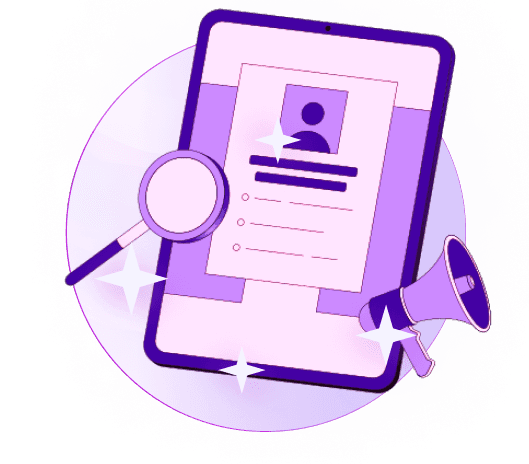Blogs
Articles

What Is Contact-Based Marketing? A Simple Guide for B2B Growth
Contact based marketing delivers remarkable results that traditional approaches can't match. The numbers tell an impressive story - response rates to these customized campaigns have reached as high as 100%, with ROI figures soaring into tens or maybe even hundreds of thousands of percent. To cite an instance, a targeted campaign that focused on just 30 restaurant chain CEOs saw a 70% response rate.
This piece explains what contact marketing is and how it is different from account-based marketing. You'll learn ways to implement this strategy to stimulate your B2B growth. We'll also demonstrate methods to use marketing contacts effectively that will help you achieve the 67% improvement in deal closures - a benefit that businesses with strong sales and marketing alignment enjoy.
What is Contact-Based Marketing?
Picture yourself at a networking event. You could have a meaningful conversation with someone instead of shouting your pitch across the room. This represents contact-based marketing at its core—a targeted approach that focuses on individual decision-makers rather than entire organizations.
Contact-based marketing (CBM) targets specific individuals within companies. People know it by several names like people-based marketing, person-based marketing, and contact-level marketing. The core concept stays the same across these variations.
CBM looks beyond professional titles to understand the actual person. This approach differs from broader marketing strategies and focuses on:
Personalization: Creating messages that appeal to each contact's unique needs and interests
Data Analysis: Using detailed information from customer touchpoints to shape marketing efforts
Multi-Channel Engagement: Connecting through preferred communication channels
Relationship Building: Creating lasting connections with decision-makers
Sales-Marketing Alignment: Teams working together to convert leads effectively
Contact-level marketing helps you reach specific stakeholders who make buying decisions directly. You choose the person, the creative, and the timing instead of using the "spray and pray" approach. This makes attribution more accurate.
What is the difference between CRM and ABM?
B2B marketers need to understand the difference between Customer Relationship Management (CRM) and Account-Based Marketing (ABM) to implement their marketing strategies effectively.
Both approaches aim to improve customer experience and increase revenue. The similarities often create confusion. Their focus and methodology set them apart significantly.
CRM software helps manage all customer interactions throughout the sales funnel and post-purchase service. Companies use it to track contacts, manage deals, and keep customer history for their entire customer base. The system serves as a record keeper for sales activity, individual performance metrics, and revenue tracking.
ABM takes a different approach by targeting specific high-value accounts with customized marketing and sales strategies. This method identifies and engages with decision-makers in targeted organizations. The messaging adapts to address their specific needs.
Key differences include:
Scope: CRM manages your entire customer base, while ABM focuses on select high-value accounts
Data Requirements: CRM works with broad customer data like contact information and interaction history. ABM needs detailed firmographic and behavioral data for personalization
Integration: CRM connects with various tools including customer service platforms. ABM integrates specifically with sales and marketing tools
Contact-Based Marketing vs. Account-Based Marketing
The difference between fishing with a net versus a spear pops off the top of my head when comparing marketing strategies. Contact-based marketing (CBM) and account-based marketing (ABM) showcase this fundamental difference in B2B approaches.
CBM targets individual decision-makers in a broad market. This makes it perfect for businesses that want to reach a wide audience. ABM takes a different path by focusing on specific organizations or key accounts. B2B companies find this approach ideal to target high-value accounts with complex decision-making units.
These strategies are nowhere near alike when it comes to scalability. CBM provides adaptable solutions through marketing automation and personalization tools. ABM doesn't scale as easily because each account needs customized campaigns.
The way resources get distributed shows clear differences between these approaches:
CBM spreads resources across many contacts, which can water down the effect per individual
ABM focuses resources on fewer accounts, which creates stronger effects per target
Key Components of a Contact-Based Marketing Strategy
A successful contact-based marketing strategy combines several interconnected components. Your approach should be well-laid-out yet adaptable enough to match changing customer behaviors.
1. Personalization
Personalization is the life-blood of contact-based marketing. The strategy goes beyond using contacts' names. It creates messages that match each person's needs, challenges, and interests. Research proves that people want personalized content—studies show personalized emails deliver 6x higher transaction rates. Understanding what drives each contact helps create content that strikes a chord at a personal level. This makes them feel valued instead of being just another database entry.
2. Data analysis and insights
Data runs the engine of contact-based marketing. A full picture of contact behavior, priorities, and interaction history gives deep insights into individual needs. Smart analytics tools process information from different touchpoints—website visits, social media interactions, and purchase history. This helps understand each contact better. Evidence-based decisions lead to better resource allocation.
3. Customer journey mapping
The typical customer requires eight touchpoints before buying. Customer journey mapping shows these touchpoints and reveals how contacts move from awareness to purchase. This process lights up:
Customer's decision progress
Touchpoint usage patterns
Opportunities for tailored participation
Areas needing attention
Journey mapping helps everyone in the organization understand how customers interact during their lifecycle stages.
4. Segmentation and targeting
Contact-based marketing groups contacts with matching characteristics to focus efforts better. Groups can form based on demographics, psychographics, behavior patterns, or desired benefits. Good segmentation needs:
Clear differences between segments
Segments big enough to target
Segments wanting different benefits
Easy access to each segment
5. Multi-channel engagement
Contact-based marketing works best when reaching contacts where they pay attention most. This multi-channel approach delivers messages through each person's preferred channel—email, social media, phone, or face-to-face interactions. Customer information flows naturally between channels, creating consistent experiences everywhere.
6. Feedback and optimization
Constant improvement is a vital final component. Contact feedback helps refine marketing efforts for better outcomes. A feedback loop that gathers, analyzes, and acts on responses keeps campaigns relevant as time passes.
How to Implement Contact-Based Marketing in B2B?
A methodical approach helps you get the most out of contact-based marketing. Here's a practical five-step framework that will get your strategy moving quickly.
Step 1: Define your goals and KPIs
Your business goals should drive clear objectives. You might want to increase conversion rates, speed up sales cycles, or improve customer retention. Make your goals specific and measurable. Pick KPIs that show these objectives directly - account engagement rates, pipeline velocity, conversion rates, and ROI per account. A regular review of these metrics helps you spot areas to improve and refine your strategy.
Step 2: Build and verify your B2B contact list
A high-quality b2b contact list is the foundation of successful contact-based marketing. Start by creating your ideal customer profile with criteria like industry, company size, and job functions. Next, find companies and decision-makers that fit this profile. HubSpot and similar tools can help you manage your marketing contacts better. B2B databases decay at over 36% per year, so you should check all contact details often to reach the right people.
Step 3: Segment and personalize your outreach
Your contacts should be divided into meaningful segments based on roles, engagement levels, and interests. To name just one example, you could create segments like "High-Engagement, No Purchase" or "Champions in Waiting" to customize your approach. True personalization goes beyond using names—it creates content that speaks directly to each contact's specific needs and challenges.
Step 4: Choose the right marketing channels
Your target audience has preferred online spaces. Each contact might prefer different channels—email, social media, live chat, or content marketing. Your audience demographics and behavior patterns determine the right mix. Email works well with personalized content, and SMS shows amazing results with click-through rates up by over 300%.
Step 5: Work with sales and track performance
Sales and marketing teams need to work together smoothly. Set shared goals, standardized definitions, and keep communication consistent. Both teams stay in sync through regular meetings to analyze key metrics. You can measure campaign success through website visits from target contacts, engagement rates, and conversion metrics.
Persana.ai offers advanced tools to improve your contact-based marketing strategy with better targeting precision and engagement.
How Persana Supports Contact-Based Marketing

Persana stands out as a valuable partner for businesses that want to excel in contact based marketing. The AI-driven platform changes the way sales and marketing teams identify, participate with, and convert prospects. It puts the focus on individual contacts instead of just accounts.
The platform provides a complete solution to tackle major challenges in contact marketing. Your search for potential sales leads becomes easier as Persana searches more than 75 databases at once. The platform learns from each search to understand your exact requirements. This approach will give a consistently accurate and current b2b contact list, which solves the common issue of outdated databases.
The platform's standout feature lies in spotting buying signals. It monitors over 75 indicators of buying intent—ranging from job changes and funding rounds to website visits and keyword intent. You receive immediate alerts when prospects switch roles, which lets you reach out at the time contacts are most likely to respond.
The platform's individual-specific capabilities allow teams to:
Automate lead generation and outreach at scale
Craft personalized messages for each prospect
Trigger outreach based on key signals like job changes and social media engagement
Persana blends naturally with popular CRM systems like Salesforce and HubSpot. This connection ensures sales data flows efficiently between platforms and removes barriers between sales and marketing teams.
Conclusion
Contact-based marketing has emerged as a game-changing progress in B2B outreach strategy. This piece shows how this approach changes focus from targeting entire organizations to reaching individual decision-makers directly. The numbers tell the story clearly - response rates reaching up to 100% and ROI figures in the tens of thousands of percent.
CBM delivers genuine personalization through evidence-based insights, which creates real connections instead of generic pitches. Traditional marketing approaches fall short here. The core components we discussed - from data analysis to multi-channel participation - create a framework that enables sales teams to reach prospects at their most receptive moments.
The difference between CBM and ABM matters greatly. Account-based marketing targets whole organizations, while contact-based marketing focuses on specific individuals. This leads to better resource allocation and often shorter sales cycles.
Persana delivers the AI-driven capabilities needed to spot buying signals, keep contact lists accurate, and create personalized messages at scale.

Create Your Free Persana Account Today
Join 5000+ GTM leaders who are using Persana for their outbound needs.
How Persana increases your sales results
One of the most effective ways to ensure sales cycle consistency is by using AI-driven automation. A solution like Persana, and its AI SDR - Nia, helps you streamline significant parts of your sales process, including prospecting, outreach personalization, and follow-up.



